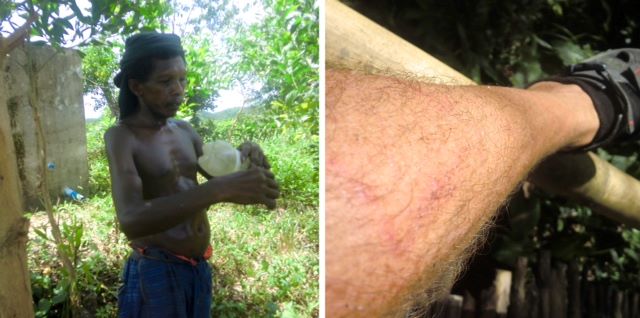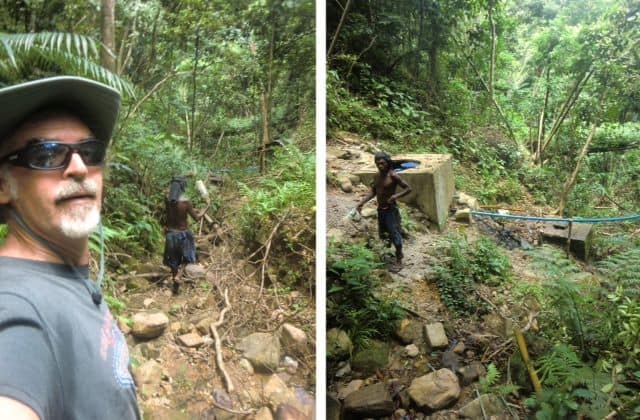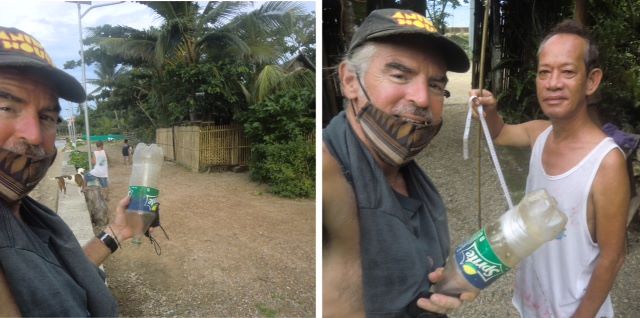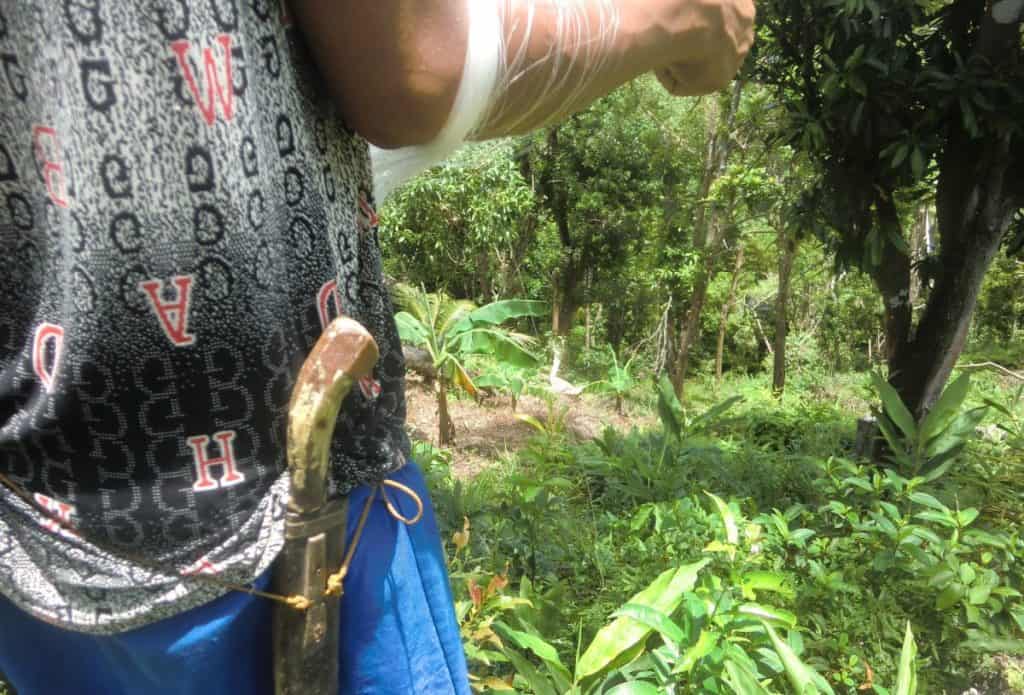Last Updated on October 27, 2024 by Ellen
A guy with a macheté. Another with a Coke bottle and fishing line. And me, with my legs all scratched up.
What do they have in common?
Another chapter in our ongoing work with the disadvantaged, indigenous Ati tribe here in Malay, Aklan, Panay, Philippines.
Challenging measurements for electricity
This time, a measurement. We need to know the actual distance from the source of fresh, drinkable, spring water to the huge cement storage tank that already exists, but is not in use, above the upper Ati village near the recently restored hen house.
The plan is to purchase a big plastic water tank (1,000 liters minimum) and install it next to the spring, so it can naturally fill with potable water. Then, use an electric pump to pipe the collected water up to the bigger holding/dispersal tank above.
The main problem; in between the two locations is extremely steep, dense, untamed jungle. No visual sight line exists. From either terminus; somewhere up/down there is where we need to go.
Waiting for power
Of course, all of this is immaterial at present. We are currently waiting for the local power company, AKELCO (Aklan Electric Company) to hook up about 20 small Ati homes and energize the main line to the village that was hung weeks ago.
Without that power, any further wiring or a pump is useless.
Still, we need to be prepared to act on ‘phase 2’ (the water pump) as soon as AKELCO does start the numerous household connections that are tentatively scheduled.
In fact, I was personally told by an AKELCO engineer that the water pump extension would likely require a ‘step-up transformer’.
Whatever is required, I want to make sure AKELCO knows we are ready and able to supply the materials required of the Ati to make it happen.
Obviously then, the measurement of THE distance is important.
Making the measurements for electricity
So the other day, Ati tribesman Jové and Michael and myself set about accurately measuring how much wire – and pipe – will be needed to facilitate the plan as envisioned.
We purchased more than 500 meters of fishing line. Wound it around an empty 1.5 liter Coke bottle. Secured the loose end at the upper water tank. And started slashing our way steeply down through thick brush toward the spring source – carefully unspooling the measuring line as we went.

What a chore! I fell down at least three times. My legs were all scratched and scraped by wild branches and rough foliage (I shouldn’t have worn shorts). The thought of poisonous snakes was constantly on my mind. Yet, we got it done.
After about 40 minutes, we had made it to the spring, where water is already collected in another big plastic tank and piped via gravity downstream.
The fishing line laid behind us. From the top. No breaks. No tangles. No reason to doubt the measurement. We cut the line at the bottom.
After a few minutes break and celebration, we hiked out the ‘easy way’ – the well-worn footpath the Ati have used for years to fetch drinking water from this precious spring. It is steep, rocky, muddy, slippery – dangerous, in my opinion. Exactly why the tanks and pipe and electric pump are needed.
After about 15 grueling, sweaty minutes, we were again at the top tank, where the start of our measurement line was tied. Slowly, carefully, we began pulling in the fishing line that disappeared down into the ravine, winding it onto another plastic bottle.

Ati men finish the job
At this point Jové and Michael did the work. Jové venturing a ways down again to make sure we collected the line without issue. Michael steadily coiling the crucial line.
Occasionally, some shouts between them – in Tagalog. Me; trying to supervise while perspiring profusely and itching at my reddened legs. At least I had worn socks beneath my sandals to protect my feet.
Within a few minutes, all the line had been pulled up and wound. Both guys said there had been no snags, no chance of breakage.
We now had the exact measurement of the distance from holding tank to water source below; the length of the wound nylon line.
Measuring the measure
Fast forward a few days: this afternoon I uncoiled the line from the old plastic bottle and measured it. Actually, myself and another Filipino friend, Robbie, did the measuring along the waterfront at his house in Malay city while we enjoyed a few beers.
We measured the distance between light poles at the waters edge to be 15 meters. Then we walked and unspooled the collected measuring line back and forth until it ran out. Measurements for electricity were complete.
The result: 135 meters. That will be the minimum needed for both electric cable and PVC pipe when we start the next phase of the water pump project.

Waiting and weather
Hopefully, AKELCO will find a way to make the pending residential hookups and deliver power soon. Rainy season (Habagat) has started in this region and projects are frequently delayed. In addition, there is certainly extra difficulty in accessing the remote Ati village.
I intend to make regular inquiry and encouragement to the engineer and customer service rep assigned to our project. Assuring them that any cost ‘overruns’ (beyond the allotted free services) will be promptly paid should help.
Further, we will immediately start a dialog regarding whatever is needed to supply power for the electric extension to the spring water pump that has now been painstakingly measured.
As always, be thankful and generous, happy trails & more beer.
Life is NOW!
Thanks for reading, “Measurements for electricity to upper Ati village in mainland Malay complete.”
What to read next about helping the Ati during a pandemic:
- How we met the Ati, a Philippine indigenous tribe
- Rebuilt Ati hen house destroyed by a typhoon
- Surreal experience helping the Ati in pandemic days
- Shopping in town with the Ati tribe chief and council members
- Chicken soup for the soul, Ati style

